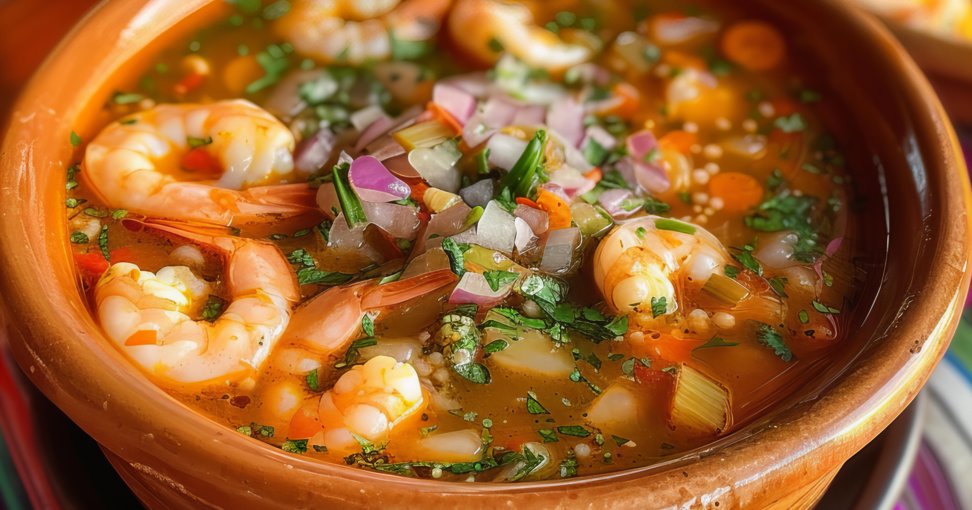Chupe de camarones

Origin and history of chupe de camarones
Chupe de Camarones is one of the most iconic soups in Arequipa’s and Peru’s gastronomy. Its deep flavor, comforting texture, and cultural value have earned it international recognition: in January 2022, it was listed among the twenty best soups in the world by CNN en Español, and it also ranks among the fifty most exquisite soups on the planet, according to the influential food website Taste Atlas.
History and roots of chupe de camarones
This dish has roots that trace back to pre-Columbian times. According to historians, in ancient times a soup called chuwa misa—which means "deep bowl" in Quechua—was prepared using Andean ingredients such as potatoes, llama meat, and native herbs.
With the arrival of the Spanish in the 16th century, new ingredients were introduced, including freshwater shrimp, which are abundant on Peru’s southern coast. These shrimp gave rise to the Chupe de Camarones as we know it today. The recipe evolved over time, incorporating products such as milk and cheese—staples of the European pantry—and reflecting a fusion of Andean, colonial, and Creole flavors.
The dish also contains an Afro-Peruvian component. During colonial times, enslaved Africans contributed techniques and flavors that became integrated into the local cuisine, enriching the preparation even further.
Etymology
The word chupe or shupe derives from the Quechua word chupi, which means "soup." This name highlights the comforting nature of the dish, ideal for cold months due to its high caloric and nutritional content.
Ingredients and nutritional value
Chupe de Camarones is a complete meal. It combines proteins (shrimp, eggs, milk), carbohydrates (potatoes, rice, corn), vegetables (fava beans, onion, tomato), and fats (cheese, oil), offering an ideal balance between flavor and nutrition. This richness of ingredients not only makes it hearty but also highly valued for its ability to nourish and comfort.
Typical garnishes and side dishes
Traditionally, Chupe de Camarones is served with pan serrano or pan de tres puntas, a typical Arequipean bread with a crunchy crust and soft interior. It is also common to add a spicy touch with ground ají or rocoto, ají de huacatay, and a few drops of lime juice to enhance the flavor of the shrimp. Black olives are also a frequent accompaniment.
In more modern versions, non-traditional ingredients such as white rice, avocado, craft beer, or chicha arequipeña are added, contributing new layers of flavor without losing the essence of the dish.
RECIPE
Ingredients:
- 1 kg of shrimp
- ½ cup of rice
- 1 cup of peeled green fava beans
- 1 cup of evaporated milk
- ½ cup of tomato paste
- 5 eggs
- 2 ears of tender corn, sliced
- 1 medium onion
- 3 cloves of garlic, minced
- ½ kg of yellow potatoes, halved
- 1 tablespoon of ají panca paste
- 100 grams of fresh cheese
- 1 cup of diced pumpkin
- 1 sprig of huacatay (black mint)
- Ground oregano
- Salt and pepper to taste
Preparation:
1. The flavor base:
In a large pot, heat a bit of vegetable oil or lard. Sauté a finely chopped red onion until transparent and slightly golden. Add two minced garlic cloves, one or two tablespoons of ají panca paste (rehydrated if using dried form), a tablespoon of tomato paste (or homemade tomato sauce), and a sprig of fresh huacatay. Cook everything over medium heat, stirring constantly, until the mixture darkens and thickens.
2. Shrimp broth:
Add about 5 cups of water to the sautéed mixture and bring to a boil. Once boiling, add the whole shrimp (about 500 g, cleaned but with shells and heads). Cook for 3 to 5 minutes, until the shrimp turn bright red. Remove the shrimp from the broth and set them aside. If desired, strain the broth to remove impurities and achieve a smoother texture.
3. Cooking the solid ingredients:
In the same broth, add peeled and quartered yellow potatoes (3 to 4 medium), ½ cup of peeled green fava beans, ½ cup of raw rice, and sliced corn. Cook over medium heat until the potatoes are tender and the rice is done, about 15 to 20 minutes.
4. Adding dairy and seafood:
Add diced fresh cheese (about 150 g) and the shrimp coral (carefully removed from the heads). This gives the broth a deep seafood flavor. Stir well, then add one cup of evaporated milk (or fresh milk for a lighter version). Finally, return the whole shrimp to the pot just to reheat them—avoid overcooking.
5. Serving and presentation:
When serving, place a fried egg on top of each portion of chupe. Sprinkle with ground oregano and, if desired, add a few drops of lime juice to enhance the flavors.
SOURCE:
Cocina Peruana: Historia, Cultura y Sabores, Autor: Sara Beatriz Guardia, USMP